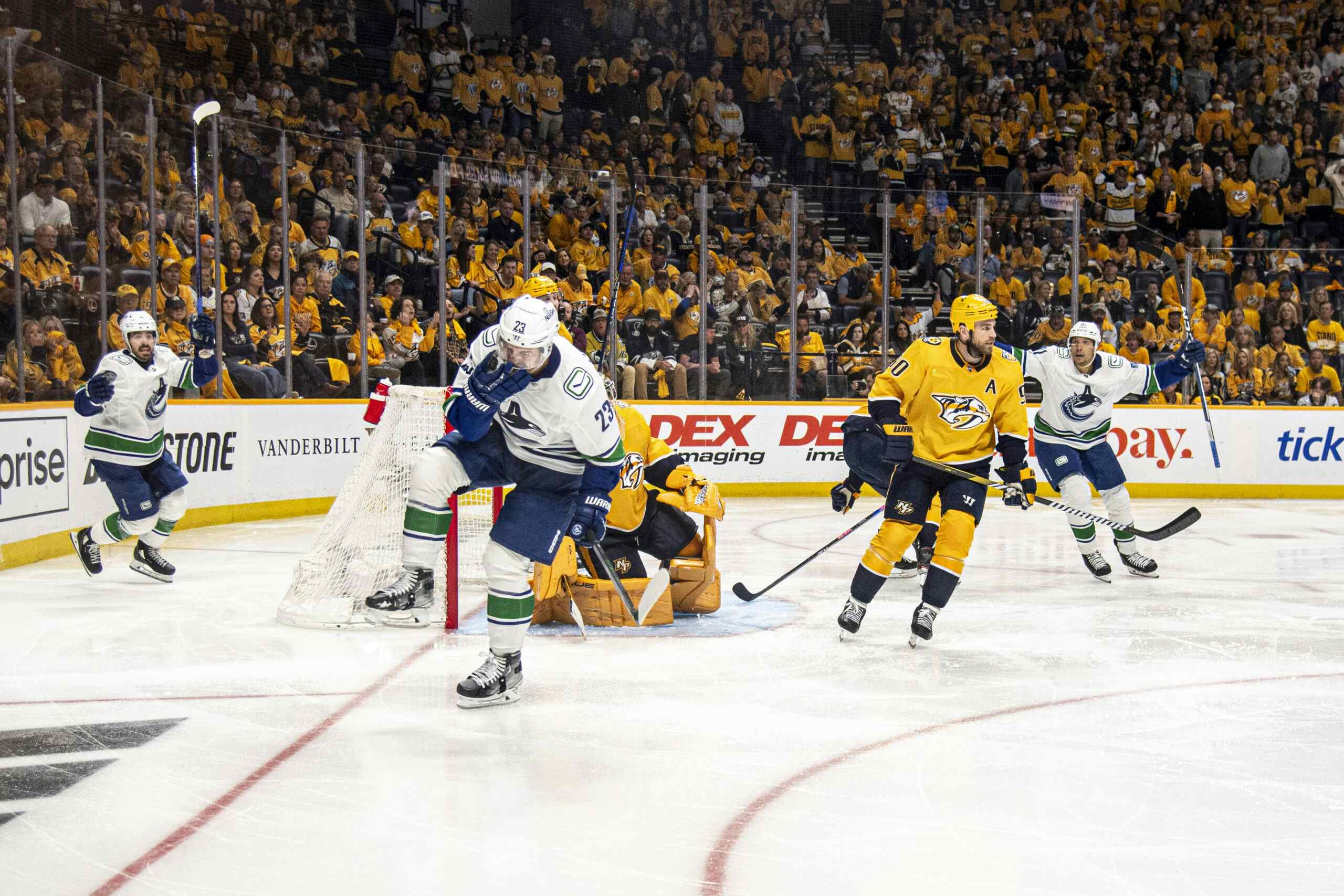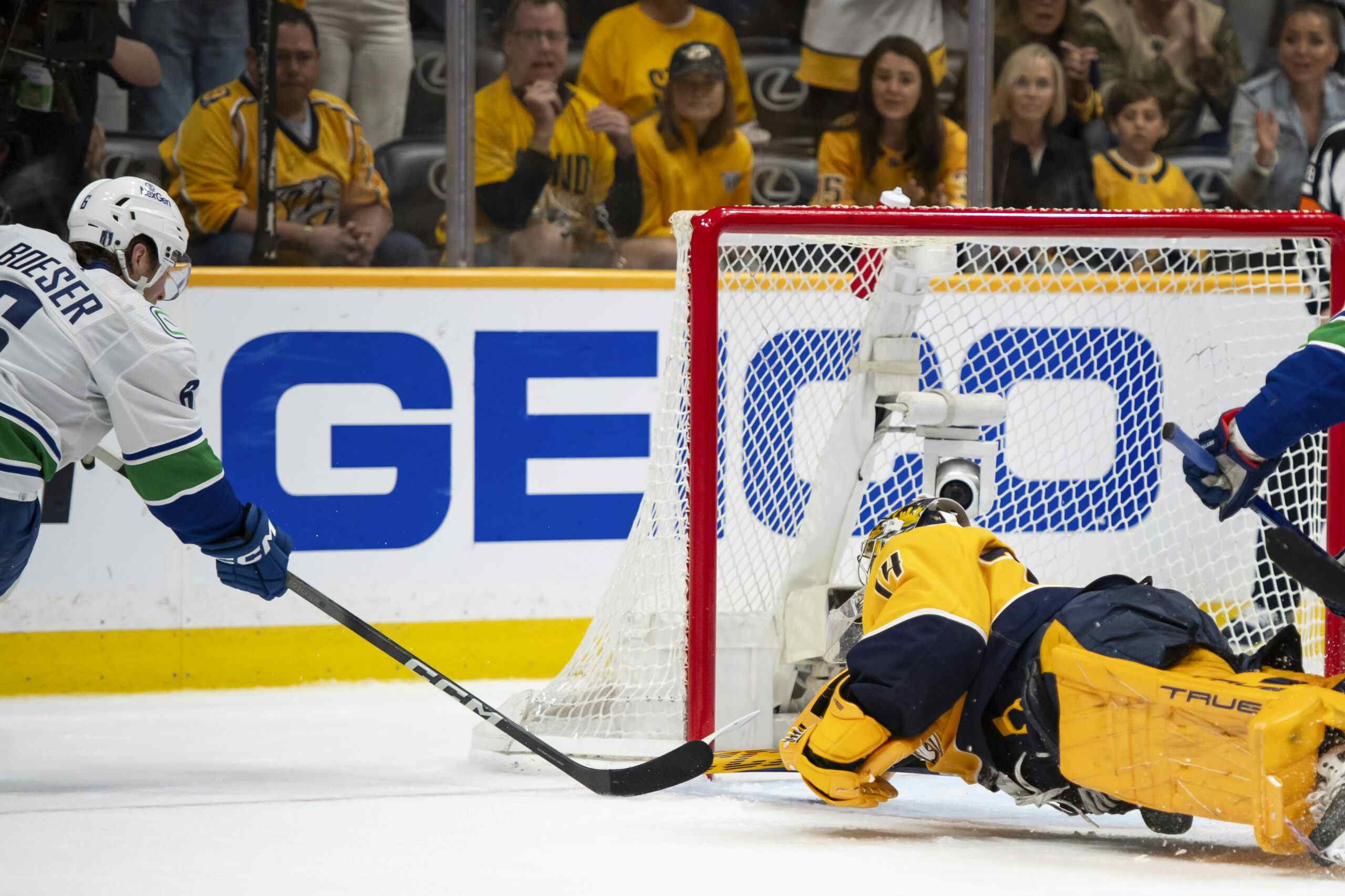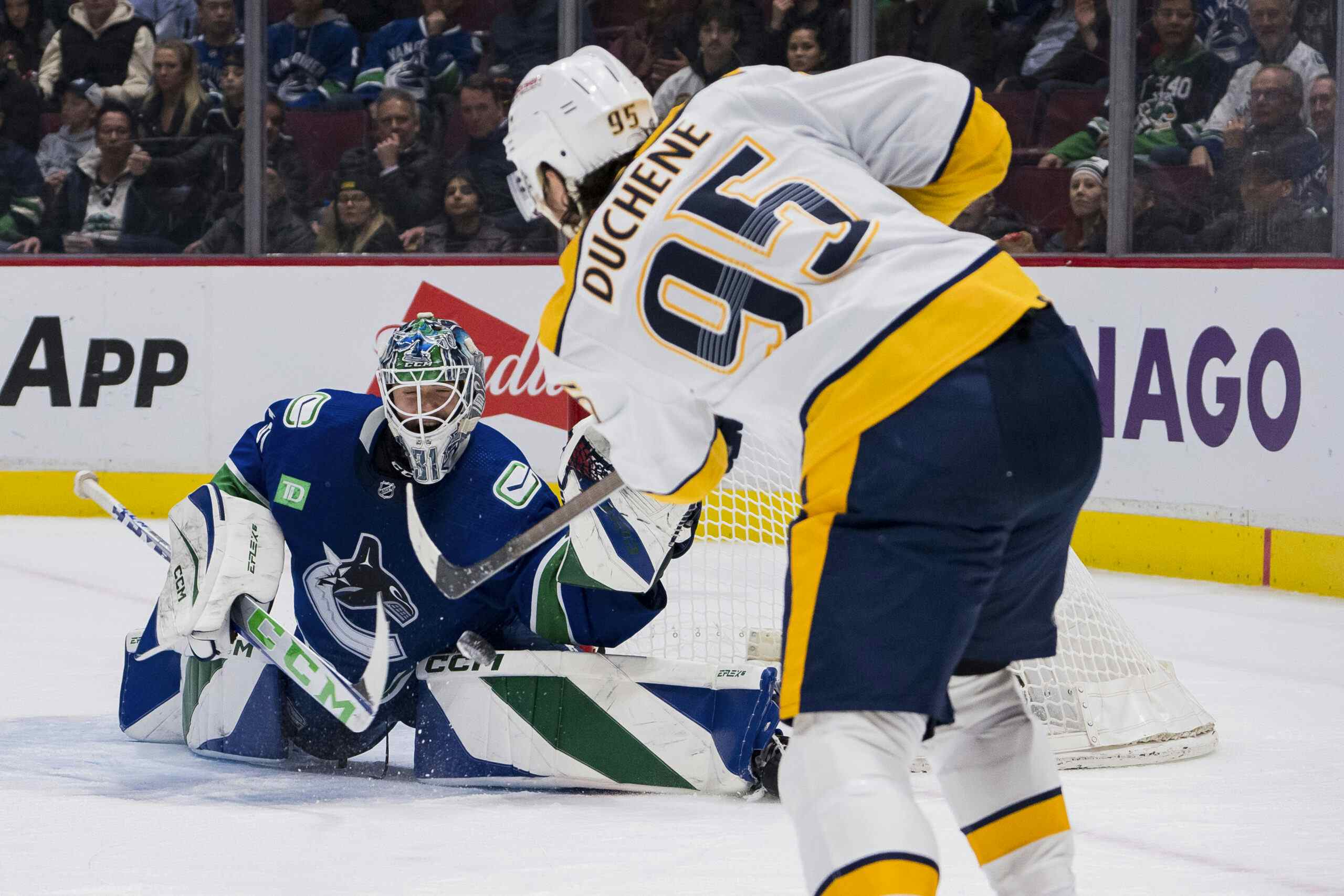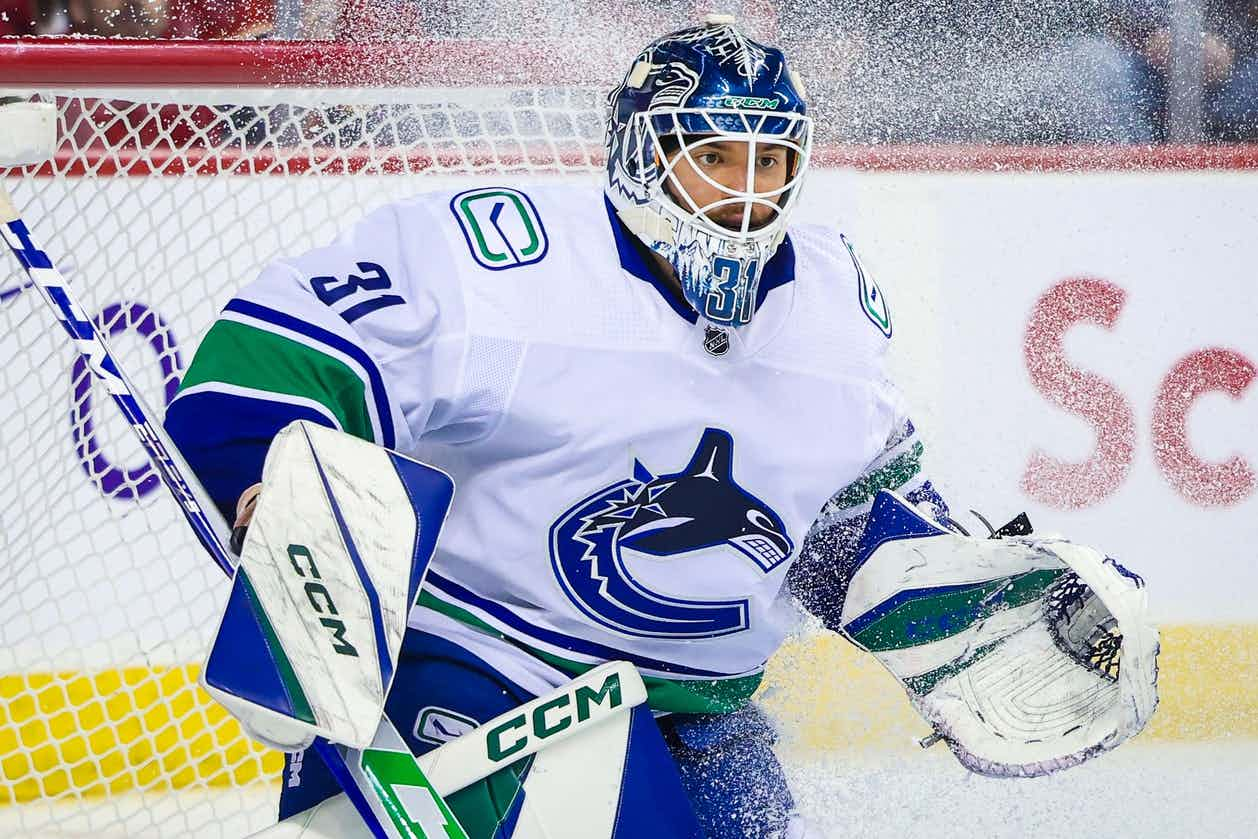Deep Dive: The Canucks Pre-Season
By money puck
8 years ago Photo Credit: Sergei Belski/USA TODAY Sports
Photo Credit: Sergei Belski/USA TODAY SportsThe 2015 offseason was challenging for the Canucks front office. Gone were faces of the franchise like Kevin Bieksa and Eddie Lack, and a host of complimentary players that helped the Canucks return to the postseason (Brad Richardson, Shawn Matthias, Zack Kassian, and Nick Bonino). You can debate at length whether or not the Canucks received fair value for the players they moved, and believe me we have, but with the regular season right around the corner it’s time to look forward and discuss what type of team we will have for 2015-16.
Forwards
As reported last week, Benning is planning on trying three combinations with the twins early on – Vrbata, Burrows, and a mystery third winger which Thomas Drance speculated may be Jannick Hansen (again?!?). Here is how those three combinations performed in the 2014-15 regular season:
| 2014-15 Regular Season | GF% | CF% | TOI Together (Min) |
|---|---|---|---|
| Sedin/Sedin/Vrbata | 58.8 | 54.7 | 540 |
| Sedin/Sedin/Burrows | 42.9 | 57.1 | 293 |
| Sedin/Sedin/Hansen | 60 | 63.8 | 51 |
h/t to puckalytics.com
As we can see, the Vrbata combination was pretty dominant last year at even strength, in terms of both goal and shot attempt differential. Given that Vrbata is a UFA in 2016 and a new contract does not appear to be in the plans, it would make a lot of sense to give Vrbata the benefit of playing with the Sedins to maximize his trade value.
While dominant in terms of shot attempt differential, the Burrows combination was outscored by a significant margin as a result of low on-ice shooting percentage (5.3%) when the three were on the ice together. We can be pretty safe in expecting this to improve if they were to play together again this season as the line has shot at a rate of 8% when together over the past 4 years.
However, the better move may be to play Burrows further down the lineup. As an option, Burrows and Higgins showed very good chemistry together last season, producing an elite second line shot attempt differential, although their goal differential was negatively impacted by unusually low save percentage when they were on the ice together.
| 2014-15 Regular Season | GF% | CF% | TOI Together (Min) | sv% |
|---|---|---|---|---|
| Burrows/Higgins | 48.5 | 53.3 | 340 | 88.28 |
The Sutter acquisition has taken a fair amount of heat here at CanucksArmy and elsewhere, but when you break down his 2014-15 season, there is a reason for a fair amount of optimism in terms of his ability to score (G60), maintain strong penalty differential (PenD), and minimize high danger scoring chances against (HSCA60). The following table shows Sutters rank among the 192 centers who played 40 or more games last season:
| G60 | PenD | CF% | HSCA60 | |
|---|---|---|---|---|
| Sutter | 0.77 (rank 49) | 5 (rank 48) | 49.48 (rank 112) | 12.95 (rank 30) |
Sutter’s most common linemates over the past three seasons have been Beau Bennett, Matt Cooke, Steve Downie, and Nick Spalling, so it’s not hard to imagine the Canucks being able to put together a relatively strong second line if Sutter were paired with two possession driving wingers like Burrows and Higgins. In any case, will be looking to Sutter’s line to chip in a significant amount after giving up three of the teams four most efficient even strength goal scorers last year (Matthias, Kassian, and Bonino).
The bigger question mark is what to expect from Bo Horvat in his second pro season. While his rookie year was really impressive, Horvat wouldn’t be the first 20 year-old sophomore to slump under heightened (read: unrealistic?) expectations. While his overall possession numbers weren’t impressive (44.7%) on their own, when he was on the ice without Derek Dorsett, his numbers jumped considerably (48.7%). With Baertschi, Kenins, and Virtanen all looking to earn a top 9 spot on the wing, it pretty hard to predict how this line in particular will come together, but if Virtanen and Baertschi don’t manage to stick with the Canucks have reason to believe a Hansen, Kenins, Horvat could be an effective 2b/3 line based on the time they spent together last season (CF%: 52% in 249 minutes).
Even by fourth line standards, it’s hard to get excited about Linden Vey, Derek Dorsett, and Brandon Prust. Prust only managed a shot attempt differential of 45.3% last season, despite playing the year with Lars Eller as his most frequent center. That said, Vey and Dorsett managed a shot attempt differential of 47.3% in 310 minutes together last season, so if the fourth line can play limited minutes without getting killed, the overall forward core could take a big step forward at even strength.
Defense
If there was one sure thing on the Canucks blue line it is that they will be led by the top pair of Alex Edler and Chris Tanev. The two combined for a shot attempt differential of 52.5% and a goal differential of 53.4% when on the ice together last season. This was an impressive result considering they typically faced off against the opposition’s top lines. Tanev and Edler got the job done last year, and I don’t expect there to be much change for that pairing in 2015-16.
Things are much more uncertain for the other combinations, with the departure of Kevin Bieksa, promotion of Frank Corrado, and the addition of Matt Bartkowski.
For example, Dan Hamhuis played 39% of his even strength time with Yannick Weber last year, and pair managed a pretty decisive edge in shot differential at 52.1%. Corrado is another strong alternative to play with Hamhuis. The two played together briefly when Corrado was called up last season, and the two managed a shot attempt differential of 53.2% during that span.
This would also allow Weber to play with newly acquired Matt Bartkowski on the third pair, who shoots left (Weber is a right shot). Bartkowski had the unfortunate assignment of playing alongside Dennis Seidenberg last season, who has seen a Bieksa-like decline in his play. When playing away from Seidenberg, Bartkowski managed a shot attempt differential of 53.6%.
With the addition of Bartkowski and promotion of Corrado, coach Desjardins has a very real opportunity to improve his top 6 considerably from last year, assuming Desjardins manages his ice time efficiently (ie not to Sbisa).
Goaltending
Goaltending is perhaps the largest question mark for the Canucks this season. Ryan Miller has had an outstanding NHL career, but at age 35 he’s showing clear signs of decline. Here is his aging curve, using the waronice.com team’s goals against replacement metric I described here:

While Miller’s play has been in decline for a while now, the bigger concern has to be around how well he has recovered from the knee injury that sidelined him last season.
Even if he does bounce back to his 2014-15 form, which was slightly below averaged for an NHL starter, the Canucks will dependent on receiving a fair amount of quality starts from Jacob Markstrom, who has been anything but dependable at the NHL level. That said, management liked what they saw from him when he took the Utica Comets to the Calder Cup final. We’ll soon see whether or not they bet on the right goalie when they decided to ship Eddie Lack to Carolina.
There is actually some reason to believe Markstrom will be better than he’s looked so far. Of the 31 goalies who have played over 500 minutes in both the AHL and NHL over the past 4 years, Markstrom has seen by far the largest decline in save percentage when moving from the AHL to NHL:

Sorted from increase to decrease in save percentage from AHL to NHL, we see a graph bookended by Andrew Hammond and Jacob Markstrom on either end. Just as it is unlikely that Hammond maintains the 0.942 even strength save percentage he enjoyed in Ottawa last year, it’s probably just as likely that Markstrom sees noticeable improvement from the 0.904 ES save percentage he’s endured over the course of his NHL career.
Special Teams
The 2014-15 edition of the Vancouver Canucks earned 101 points, not because of their play at even strength, but because they had the 9th ranked power play in the league in terms of power play percentage (19.3%) and second-ranked penalty kill (85.7%).
It’s unlikely we’ll see much change to the first power play unit (Henrik, Daniel, Edler, Vrbata, Weber/Burrows) which was pretty effective last season, but there’s reason to be excited about the potential for an improved second unit with the departure of Bonino and Bieksa who didn’t do a whole lot last year. It remains to be seen whether Sutter will assume Bonino’s spot by default, or whether they give Horvat an opportunity to show what he can bring.
In terms of the penalty kill, the old saying goes that your goalie is your best penalty killer, and Ryan Miller was lights out in this area last year. He posted a short-handed save percentage of 88.95%, which was seventh best in the league last year. They’ll miss Shawn Matthias and Kevin Bieksa, both of whom were solid on the PK last year. Bartkowski should be able to step into Bieksa’s role, having posted a very similar rate of scoring chances against (Bartkowski – 46.15 scoring chances against/60 min, Bieksa 45.49 scoring chances against/60 min). The real minefield for the Canucks coaching staff will be Brandon Sutter and Luca Sbisa, who were among the worst penalty killers in the league last year in terms of scoring chances against per 60 minutes, at 58.54 and 60.6 scoring chances against per 60 minutes, respectively, despite both playing on some of the better penalty kill units in the league last year.
Conclusion
The Canucks made a lot of transactions this season and, to be honest, I think they ended up on the wrong end of most of them. That said, despite giving up incremental value in each move, I don’t disagree with the team’s assertion that they could be improved this season.
Make no mistake about it, the Canucks are in tough in a stacked Western conference. The Flames won’t get the puck luck they did last year, but they’ll be a better team with the additions of Michael Frolik, Dougie Hamilton and a healthy Mark Giordano. Edmonton will be better with Connor McDavid, Griffin Reinhart, Andrej Sekara, and Cam Talbot. Dallas added Johnny Oduya and Patrick Sharp. While LA lost Justin Williams, they added Milan Lucic. Top to bottom, there are less easy points available in the Western Conference than there were last year.
That said, provided they get average goaltending out of Markstrom and Miller, this is still a team built around an elite possession driving first line/pair with the Sedins and Edler/Tanev. Their defense will be better provided Corrado and Bartkowski eat up the minutes Sbisa and Bieksa were allocated last year, and with possession driving veterans like Burrows, Hansen, and Higgins in the middle six, its far more likely this team will find themselves in a dog fight for a wild card spot, than tanking for Matthews.
They are not a Stanley Cup contender by any stretch, but they’re not going to be in the race for Auston Matthews either. This should all culminate in an interesting run-up to the trade deadline with Radim Vrbata and Dan Hamhuis on contracts that expire this summer, and a Canucks prospect pool that has improved, but still desperately lacks top end talent that could be acquired in a very deep 2016 draft.
Recent articles from money puck





